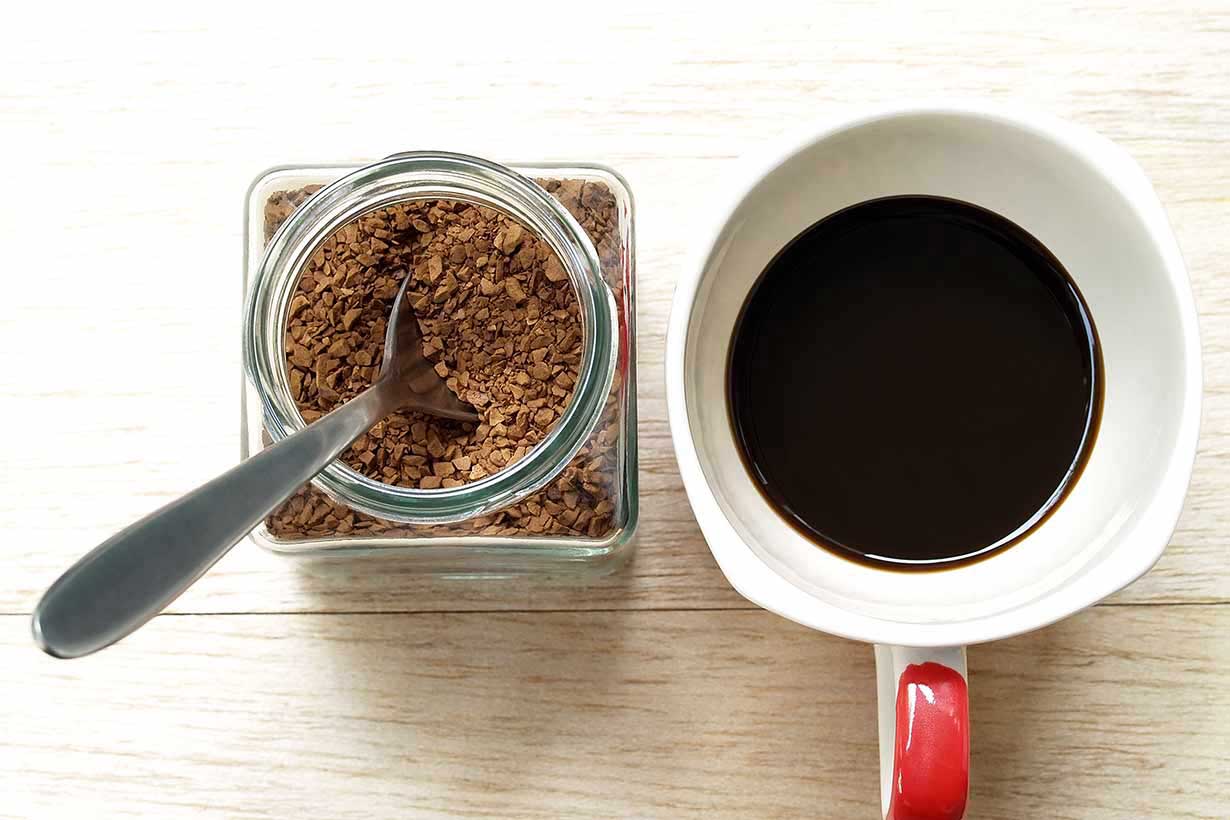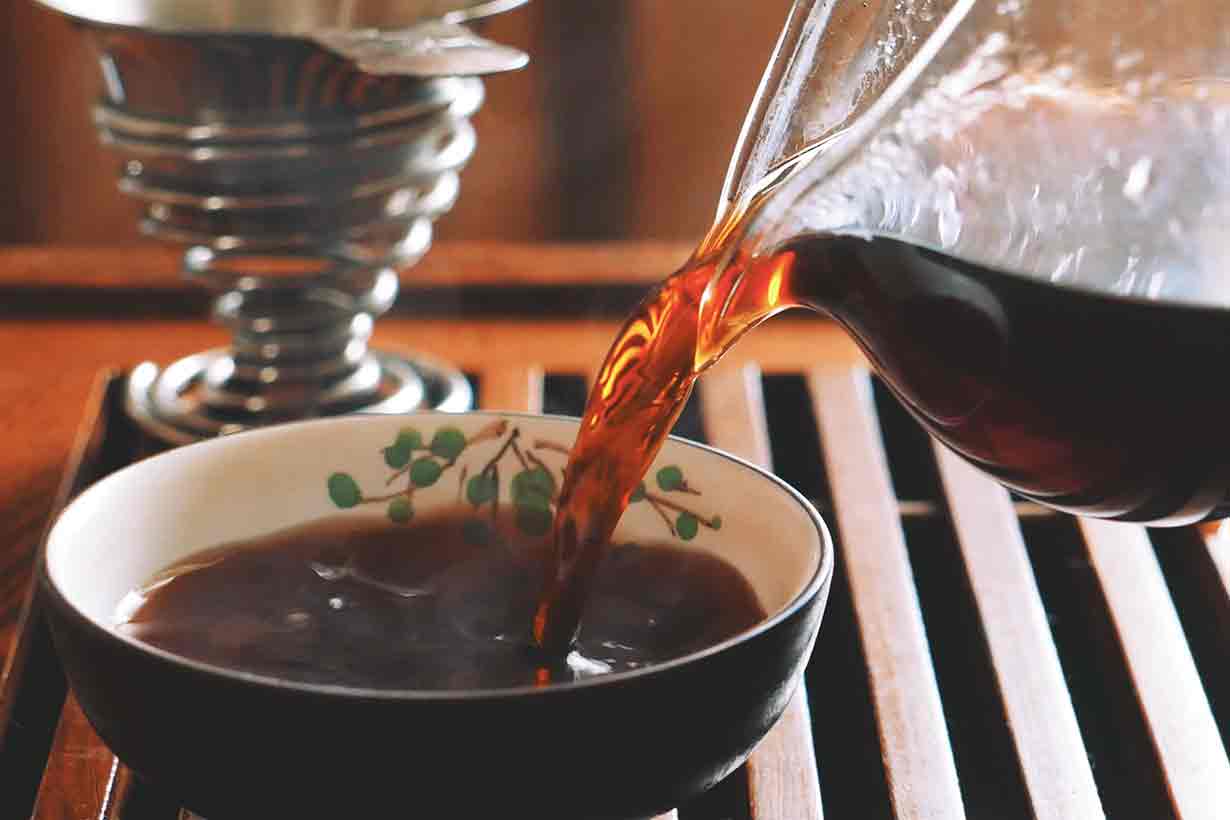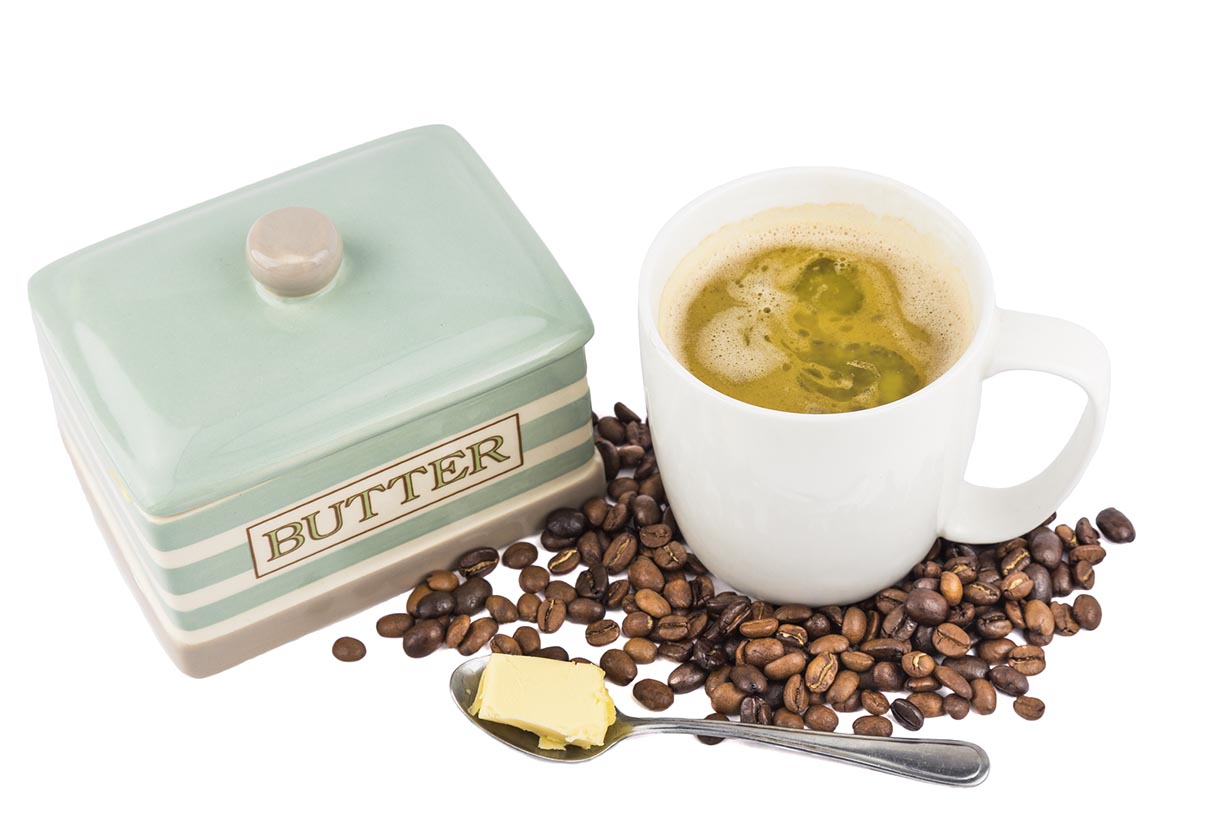Caffe latte is one of the most popular coffee drinks globally, but is it a healthy choice?
When we consume a latte, what exact nutrients are we getting?
And does a caffe latte have any clear benefits or drawbacks in contrast to regular black coffee?
Let’s dive into the nutritional properties and scientific research on latte to find out.
Table of contents
What Is a Caffe Latte?

Before we start, let’s first make sure we know exactly what a caffe latte is.
Put simply, a caffe latte is just espresso coffee mixed with hot, foamed milk. The exact ratio of milk to espresso will vary from place to place, but it’s typically at least two parts milk to one part espresso.
While most people drink caffe latte in a cafe or coffee shop, it is also possible to make them at home using specialized coffee-making machines.
Key point: Caffe latte is an espresso-based coffee drink made by mixing espresso with foamed milk.
Nutritional Values of Coffee Shop Caffe Latte
What is the typical nutritional profile of a caffe latte from a popular coffee shop?
The following section provides the calorie, macronutrient, vitamin, and mineral profile of a caffe latte, courtesy of data from the USDA FoodData Central database.
In the table, you can see the basic nutritional properties of a 16 oz (480-gram) caffe latte made with 2% milk. This size is equivalent to a Starbucks ‘Grande’ (1):
| Nutrient | Amount | % Daily Value |
|---|---|---|
| Calories | 206 kcal | |
| Carbohydrates | 20.9 g | 8% |
| Fiber | 0 g | 0% |
| Sugars | 19.5 g | |
| Fat | 7.73 g | 10% |
| Saturated fat | 4.5 g | 23% |
| Monounsaturated fat | 1.59 g | |
| Polyunsaturated fat | 0.31 g | |
| Protein | 13.5 g | 27% |
| Cholesterol | 33.6 mg | 11% |
As the table shows, a caffe latte provides a moderate amount of carbohydrates, fat, and protein.
Please note: These nutritional values could significantly change depending on the type of milk used.
For example, whole milk would increase the overall fat and calorie content, whereas skim milk would decrease it. Additionally, opting for a plant-based milk would affect many of the nutritional values.
Vitamins
- Riboflavin: 53% of the daily value (% DV)
- Vitamin A, RAE: 37% DV
- Vitamin D: 22% DV
- Thiamin (B1): 18% DV
- Vitamin B6: 13% DV
- Choline: 12% DV
- Folate, DFE: 2% DV
- Vitamin C: 1% DV
- Vitamin E: 1% DV
Minerals
- Calcium: 39% DV
- Phosphorus: 33% DV
- Magnesium: 26% DV
- Potassium: 16% DV
- Selenium: 13% DV
- Zinc: 16% DV
- Sodium: 7% DV
- Copper: 4% DV
- Iron: 1% DV
Key point: Caffe latte is a good source of protein and several key vitamins and minerals. Since it typically contains dairy milk, it’s an excellent source of calcium.
Potential Benefits of Caffe Latte
Based on its nutritional profile and naturally occurring compounds found in coffee, a caffe latte may have several benefits.
1. An Excellent Source of Caffeine
Caffeine can be a double-edged sword and its potential benefits and downsides depend on the individual and overall context.
However, one clear benefit of caffeine is its potential to increase focus and improve exercise performance.
For example, caffeine, which is a major constituent of coffee, is a stimulant. Research shows it can help to promote attention, concentration and focus (3, 4)
Caffeine is also one of the most proven sports supplements for effectiveness. Systematic reviews demonstrate it can improve aspects like endurance, power, reaction time, and overall high-intensity performance (5, 6, 7).
Key point: Coffee contains caffeine, a stimulant that may help improve attention and sports performance.
2. High In Protein, Calcium, and B Vitamins
Since it usually contains cow’s milk, latte is an excellent source of protein, calcium, phosphorus, and B vitamins.
This is a clear benefit that caffe latte has over black coffee, which only contains small amounts of vitamins and minerals.
As we saw in the nutritional values section, a typical 16-ounce (480g) caffe latte provides 39% of the recommended daily value for calcium (1).
However, please remember these nutritional benefits are for dairy-based latte.
If you order a caffe latte made with plant-based milk, these values may differ. On this note, soy milk is the best, widely-available plant-based milk for protein, and most soy milk brands are fortified with calcium and vitamin B12.
Key point: A caffe latte is more than just coffee and caffeine; its milk content contributes several essential vitamins and minerals.
3. Rich In Polyphenols
Polyphenols are a type of plant chemical found in plant-based foods and drinks, and research indicates they likely confer health benefits.
In this regard, dietary patterns rich in polyphenols are associated with lower all-cause mortality (8, 9, 10, 11, 12).
Interestingly, studies suggest that coffee is the most significant dietary contributor of polyphenols in many populations around the world (13, 14, 15).
Further, a study investigating polyphenol intake in U.S. adults during 2007-2016 found that coffee contributed 39.6% of total polyphenol intake (16).
So, alongside its caffeine and essential nutrient composition, you’re also getting large amounts of polyphenols with a caffe latte (17).
The most concentrated polyphenol found in coffee is called chlorogenic acid.
Key point: Like all espresso-based drinks, a caffe latte contains significant polyphenol levels.
4. Non-Dairy Options Are Available
A decade ago, it may have been difficult to find a caffe latte made with plant-based milk. However, these options are common to find these days, particularly in large coffee shop chains.
This means that individuals with dairy allergy, lactose intolerance, or a vegan diet can still enjoy a caffe latte.
Again, please remember that the nutritional profile of a latte will change depending on the type of milk used.
Potential Downsides
Here’s a summary of some of the key potential downsides to be aware of when opting for a caffe latte.
1. May Contain Added Sugars and Fats
Previously, we looked at the reasonably nutritious nutritional profile of a caffe latte. However, this was for a plain latte made with 2% milk, and it is possible to find various flavored latte drinks.
For example, head to a nearby Starbucks and you’re bound to see a flavored latte drink topped with whipped cream and syrup. These drinks can add significant amounts of added sugar, added fat, and overall calories to a latte.
For instance, a 16-ounce (480g) Cinnamon Dolce Latte from Starbucks contains 340 calories, 9 grams of saturated fat, and 40 grams of sugar (18). This works out at approximately 70% more calories, double the saturated fat content, and double the sugar content of a caffe latte.
Key point: Be aware that flavored latte drinks often contain high amounts of added sugar and added fat.
2. May Contain Unwanted Caffeine
While caffeine can have clear benefits, it can also have several research-backed drawbacks, and some individuals may wish to avoid it.
These potential downsides include coffee’s ability to:
- Disrupt sleep: Caffeine can potentially interfere with sleep by decreasing sleep time, and lowering the quality of sleep. This effect is more pronounced when consumed closer to bedtime. A 2023 systematic review recommended that, to avoid disrupting sleep, coffee shouldn’t be consumed within 8.8 hours of bedtime (19, 20, 21).
- Increase anxiety: Studies show that coffee can increase the risk of suffering from anxiety and panic attacks, even in healthy individuals. This risk was heightened with larger doses of caffeine (>400 mg per day) (22, 23, 24).
However, individuals wishing to limit their caffeine intake can opt for a decaffeinated caffe latte, an option that most large coffee shops offer.
The decaffeination process removes approximately 97% of caffeine from coffee beans (25).
It is also worth noting that recommendations advise pregnant women to consume no more than 200 mg of caffeine per day due to the possibility of complications (26, 27, 28).
As always, we should view the topic of caffeine intake based on how it affects us personally. Since individual differences in caffeine sensitivity exist, caffeine intake should be considered based on how it affects you.
Key point: Caffe latte contains a high amount of caffeine, which may not be suitable for some individuals.
3. May Raise LDL Cholesterol
It is possible that regular caffe latte intake may increase levels of LDL (low-density lipoprotein) cholesterol, otherwise known as LDL-C.
First, this is because unfiltered coffee contains the compounds cafestol and kahweol, which can raise LDL-C (29, 30, 31).
A systematic review of the effect of foods on LDL-C found that unfiltered coffee causes a ‘moderate to large’ increase in LDL-C (32).
Elevated LDL-C levels are strongly linked to an increased risk of cardiovascular disease (33).
While research on the topic is ongoing, a large observational study in Norway examined the potential health outcomes of consuming filtered versus unfiltered coffee.
This study involved 508,747 adults aged between 20 and 79, and it found that, over 20 years, unfiltered coffee was associated with a higher risk of mortality than filtered coffee (34).
Interestingly, the study also found that filtered coffee intake was linked to a lower risk of mortality than not consuming coffee.
A paper filter can be used to remove cafestol and kahweol, but espresso drinks like caffe latte use unfiltered coffee.
Key point: As an espresso-based drink, caffe latte uses unfiltered coffee that contains cafestol and kahweol. These compounds can raise LDL cholesterol.
4. Milk In Caffe Latte May Decrease the Bioavailability of Coffee Polyphenols
Earlier, we discussed how the polyphenol content of coffee was potentially one of its biggest benefits. However, there is an interaction between milk and the polyphenols that coffee contains.
In a 2011 study, participants consumed either instant coffee dissolved in hot water or instant coffee dissolved in whole milk (35).
The urine of each participant was then collected for 24 hours to check for the presence of chlorogenic acid, the major polyphenol found in coffee, and its metabolites.
The amounts of these polyphenols recovered in the urine after coffee with milk were 41% lower than for coffee with hot water.
In another study that evaluated the polyphenol content of coffee, adding milk to the coffee “significantly decreased” the content of chlorogenic acid and total phenols (36).
That being said, the effect size of this interaction may depend on the type of milk, the type of coffee, the dbrewing method, and potentially individual variability, so it is hard to assume a specific % decrease that is uniform and consistent.
Further research should offer more clarity on this topic, but since milk may hinder the metabolism and absorption of polyphenols found in coffee, black coffee may offer the best option if total polyphenol intake is the aim.
That said, all coffee, including caffe latte, still contains a significant number of bioavailable polyphenols.
Key point: Caffe latte may not contain as much bioavailable polyphenols as black coffee drinks, such as Americano, due to interactions between milk and polyphenols.
How Much Caffeine Does a Caffe Latte Contain?
Based on USDA data, a 16-ounce (480g) caffe latte typically contains 173 mg of caffeine (1).
However, this is a typical, average value, and the exact caffeine content will vary by brand, type of coffee bean, and drink size.
If you are carefully monitoring caffeine intake, ask for guidance at the coffee shop.
The following table shows the caffeine content of several sizes of caffe latte from popular coffee shops (8, 9, 10, 11).
| Brand | Small | Medium | Large |
|---|---|---|---|
| Costa Coffee | 200 mg | 200 mg | 300 mg |
| Dunkin Donuts | 118 mg | 166 mg | 252 mg |
| Starbucks | 75 mg | 75 mg | 150 mg |
| Tim Hortons | 35 mg | 50 mg | 75 mg |
Is Caffe Latte a Healthy Choice?
Overall, a caffe latte offers a wide range of nutritional benefits, ranging from its protein, calcium, and B vitamin content to the potential benefits of polyphenols and, context-dependent, caffeine.
However, it may have some potential negatives compared to paper-filtered coffee, such as its potential to raise LDL-C levels.
Additionally, black coffee is likely a better option for maximizing total polyphenol intake, but a caffe latte is still an excellent polyphenol source.
For those who enjoy a latte, it can be a beneficial addition to the diet from time to time.








